Share this
OKR Framework - The Ultimate Guide For Digital Product Leaders
by Luis Gonçalves on Jan 13, 2024 5:52:31 AM
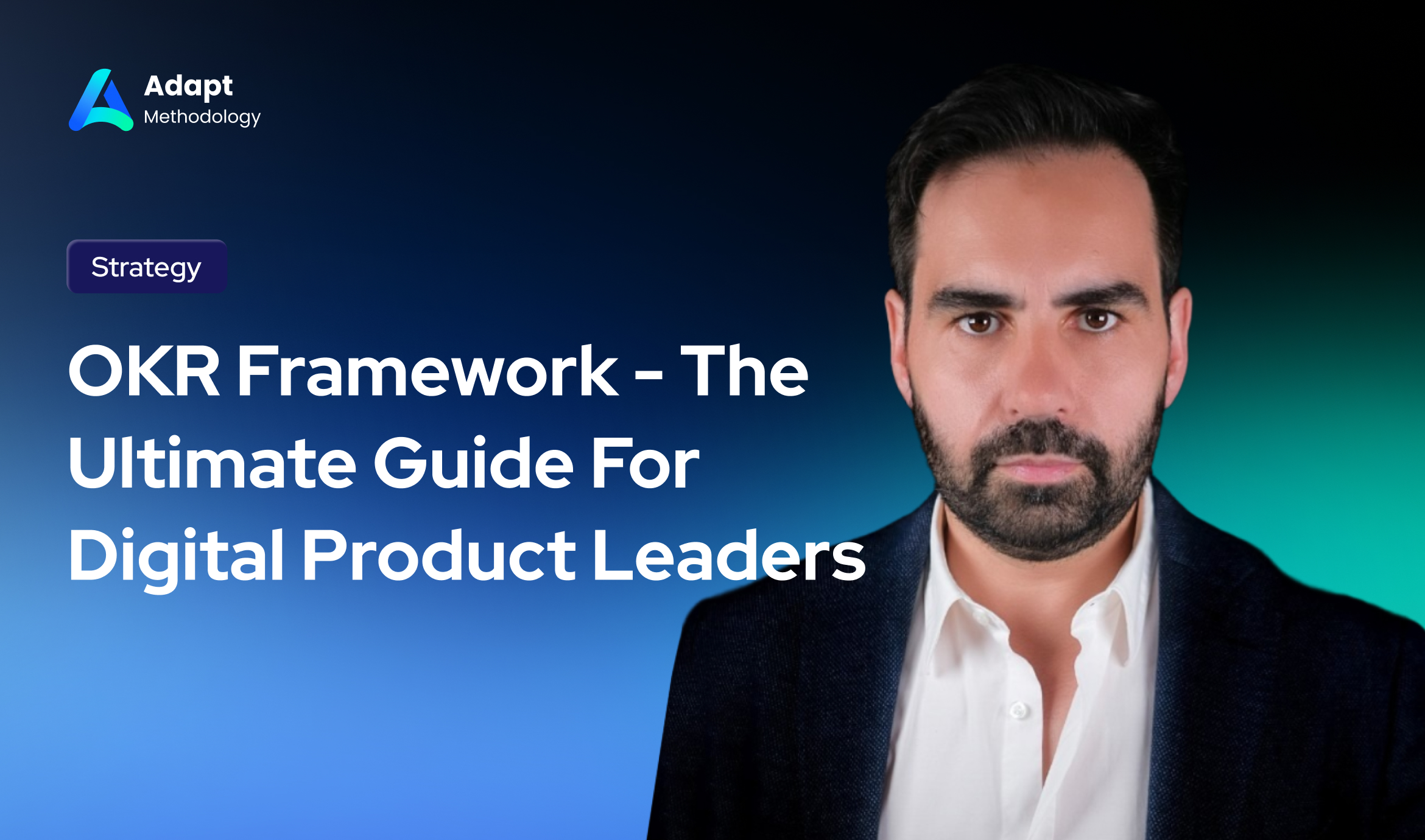
The transition from project to product thinking necessitates a deep-seated change in the strategy and operations of an organization. This is where the OKR framework plays a pivotal role. Being a goal-setting tool, it fosters alignment, engagement, and transparency, encouraging teams to focus on overarching objectives that steer toward a shared vision.
Additionally, it champions adaptability, a trait essential in the digital era where product development is a continuous, dynamic process. The agility bestowed by OKR ensures that teams can pivot quickly in response to market demands, learning, and feedback, thereby reducing time-to-market and improving the end product’s relevance and quality.
Moreover, the OKR framework empowers organizations to break down their big-picture objectives into smaller, actionable key results, effectively fostering a culture of responsibility and focus. Teams are encouraged to innovate and take calculated risks, driving not just progress but a transformative change grounded in tangible outcomes.
This systematic approach to goal setting not only nurtures a performance-driven culture but also ensures that the efforts are directed toward the most impactful areas. Therefore, incorporating the OKR framework is not just beneficial but mandatory for a successful project to product transformation, as it ingrains a product mindset, encourages iterative progress, and aligns every stratum of the organization towards a unified vision of success.
The ADAPT Methodology® is a unique Digital Product Development framework to change traditional project-centric companies toward product-led companies, but now let's get a deep dive into the OKR Framework if you want to get a deeper knowledge about this topic simply download the guide below!
The goal of OKRs is for every member of the organization – from the key stakeholders and leaders down to the team members – to understand the objectives of the company through a set of defined, specific, and measurable actions.
The OKR approach has been used by many techs and multi-billion companies like Google in Silicon Valley today.
With today’s complex nature of organisations, team members often find themselves feeling lost amidst the rapid changes that they deal with every day.
Often, the strategic plans and goals of the company are too high-level and abstract that employees don’t just feel lost, but also feel discouraged and find lack of purpose.
A little background on OKRs
It is worth knowing that the concept of OKR is not new. The long OKR history started in 1954 when Peter Drucker invented Management by Objectives or MBO.
Later it was recognised as early as the 1970s. Thanks to the former President of Intel, Andy Grove, who introduced the idea.
Which companies use OKR? OKRs are used by thousands of organizations around the world, including the largest Fortune 500 companies like Zynga, Sears, Twitter, Oracle, and so much more.
Moreover, OKRs are also gaining popularity among small organizations and start-ups, making it possible for them to achieve their goals in a much shorter period and accurately measure progress
How OKR works? A typical OKR is made up of 3 to 5 high-level objectives, under which 3-5 key measurable results are listed. The said key results are measurable through a defined set of indicators or scores (usually between 0 and 1.0. The use of quantitative indicators allows an organization to check or measure progress.
The frequency of your goal-setting process is called cadence. Just like Google, you may have annual and quarterly goals within your organization.
For your organization, you can initiate adding OKR as a critical part of quarterly planning and progress reviews. However, it can also be done on a monthly or annual basis, depending on the needs and goals of the organization.
OKRs in each department should have the same time constraint to aid with coordination and avoid complexities. Remember, OKR is meant to be a simple process.
OKR basics article tells you everything you need to know about OKRs.
OKR And Its Benefits
There are many OKR benefits but also certainly OKR disadvantages but you can learn how to deal with them and win in creating effective OKRs for your company.
Leadership experts believe that OKR is one of the leading team management practices that every company should implement.
Why use OKRs? Because it’s easy and simple, does not take up so many resources, helps preserve the company culture, and greatly benefits the organization, particularly employee productivity and performance.
Impact on Your Business
Studies have shown that employees who used OKR tend to be more effective at their jobs, which results in better performance and increased sales, than those who don’t.
Furthermore, team members who didn’t use OKRs proactively asked to be part of the OKR process in future cycles.
Company/Organisation Culture Benefits
One of the major benefits of using OKRs is that it allows an organization to greatly focus on metrics and KPIs. This makes a cultural shift from output to outcomes.
OKRs also create focus, alignment, and transparency within the organization. When combined, these factors lead to a significant improvement in employee engagement.
How to implement objective and key results
The diagram below depicts how your organizational vision is connected to every team and individual contributor in your team from the annual down to the quarterly OKRs.
Vision
│
Mission Statement
│
Long-term Goals
│
Short-term Goals (done every year)
│
Objectives and Key Results (done every quarter)
Why Does the Vision of Your Company Matter?
For an organization to get started on trying to achieve its goals, it should first determine the “Why”.
It is important for every team member to understand the purposes behind the company’s initiatives, processes, and actions.
As the leader who has to ensure Objectives and Key Results implementation by setting them, you should begin by thinking about the “end” in mind ― like how you see your company a few years from now.
The way you set your goals should be guided by what your company vision is.
Your company vision must be easily stated in one sentence. It should describe what your organization aspires to be. It’s your company’s ultimate dream ― the result of all your efforts.
Company vision statements are often mistaken for company taglines. While a vision statement can sound witty and unforgettable, it is meant for your team and culture, not to sell products.
Therefore, it is not necessary that you create a vision statement that is appealing to everyone. Just make it huge and ambitious.
It might take years for your organization to achieve such a vision, but it is the driving force that will motivate you and your employees to work hard.
How to Define a Company Mission Statement
Part of the steps involved in Objectives and Key Results implementation in your company is the definition of the mission statement. Your mission statement lays out the reason why your company exists.
For example, if an entertainment brand’s vision statement is “to make children happy,” its mission statement will be something like this:
“To be the world’s leading providers of entertainment and information for kids. Using our portfolio of brands to differentiate our content and services, we seek to develop the most creative, innovative, and profitable entertainment experiences in the world.”
When creating your company vision and mission statement, consider these tips:
- Determine the things you are passionate about.
- Envision what you intend to be at the end of the journey.
- Think about your skills, experience, talent, and resources and how you can use them to contribute to the world.
- Determine the main economic denominator that is essential for your company. Understand what drives your economic engine.
How to Strategically Plan for Your OKRs
Creating your company vision and mission statement is one thing. Achieving them is another. Using the “Hedgehog Concept”, you can attain your mission statement in the following ways:
- Focusing on what you are passionate about should help you specialize in products or services that you have a drive for. Market research can guide you in identifying industry standards and developing strategies to ensure your products and services are in high demand.
- Focus on what you do best. You should consider the resources of your company in thinking about this. That includes the skills, knowledge, and experience of your employees. You have to know your organization to determine what it is best at. It allows you to establish efficient internal processes and strategies to attain your company's vision.
- You must identify the economic metrics of your success. What level should you have reached to say that you achieved success?
Many companies utilise strategic planning systems that allow them to focus on the goals they set under each category.
However, these systems are not made to replace Objectives and Key Results as your goal-setting strategy but should be considered as instrumental to the implementation of OKRs.
Annual OKRs
In some organizations, annual goals are created through OKRs. They are now divided into quarterly OKRs to allow team members to focus on implementation.
Take note that the key results of your company will show the main metrics that the leadership team supervises and is held accountable for.
Many companies confuse “tasks” with “key results”. These two are not the same. Tasks are activities that employees have to do as part of their roles, while key results are indicators of success.
OKRs do not promote micromanaging of teams. The framework helps companies determine what constitutes success and what teams and individuals need to do in order to attain their goals.
The high-level key results are assigned either to the leadership team or the CEO. The high-level KRs can also be assigned to a specific department or team instead.
If Objectives and Key Results are too narrow from the top, by the time they have been cascaded to the team members, individual contributors might end up having a “to-do list” instead of OKRs, and therefore, be less empowered to set their own goals.
Each component of the OKR framework supports the smooth and successful implementation and thus has an important meaning in the overall process. As pluswerk consulting suggests, it is best to use the synergy effects of all components in the picture below.
OKR Framework Overview
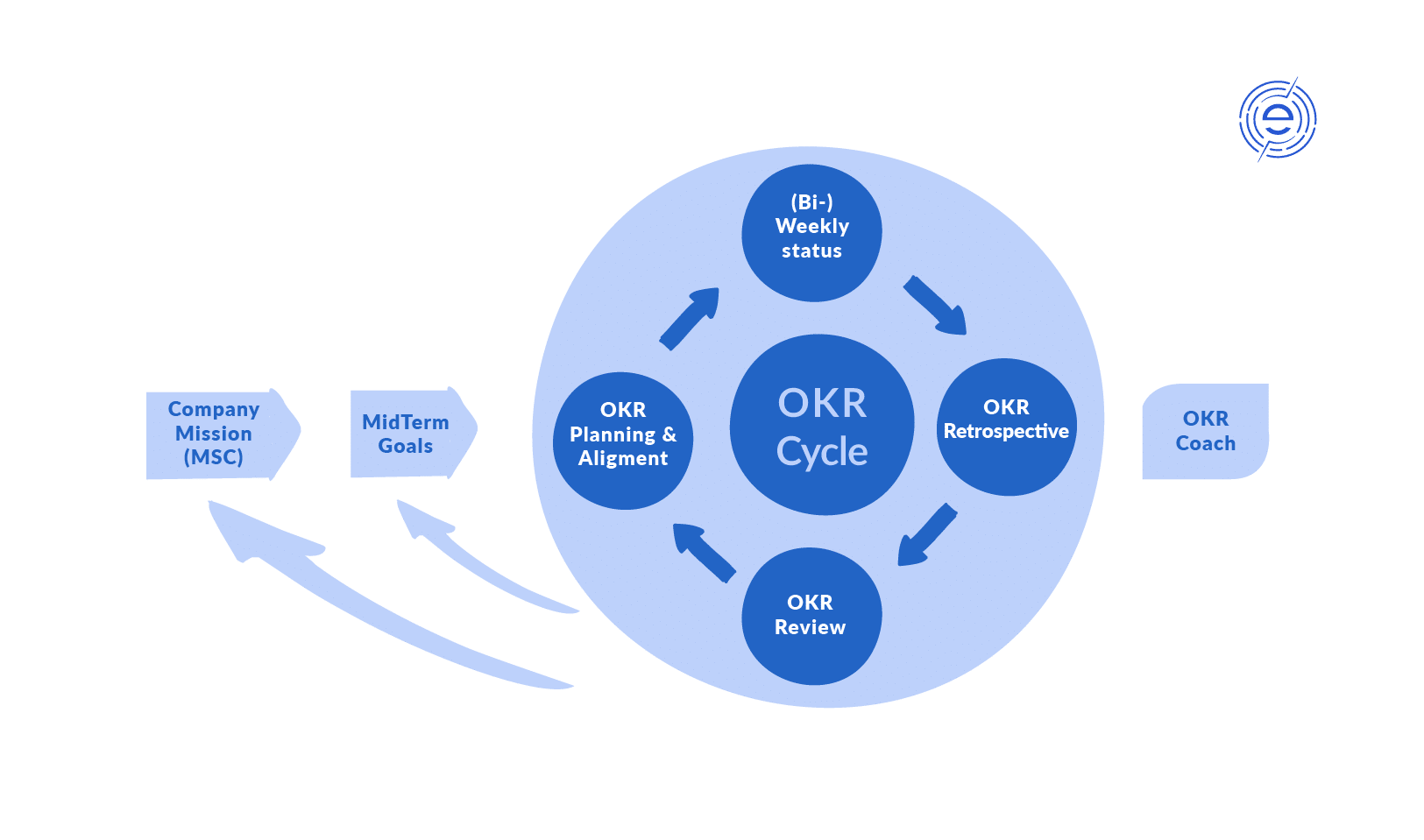
COMPANY MISSION - The company mission is a brief description of the company's vision and purpose, and how they should be implemented.
MID-TERM-GOALS - Mid-term goals (so-called MOALS) are the link between the company mission and the OKR. They are usually defined for one year.
OKR PLANNING - At OKR Planning the respective objective and key results become defined for the entire cycle and at all levels. This is done both top-down and bottom-up.
OKR WEEKLY - The OKR Weekly helps to synchronize the objective and key results implementation and supports self-responsibility as a solid ritual
of the teams during the cycle. The weekly should only take about 15 minutes and should give an overview of the current status of the OKR.
OKR REVIEW - Review meetings are used to determine the degree of achievement at the end of an evaluation cycle. The scoring should be consistent with team standards.
OKR RETROSPECTIVE - During a retrospective, the teams analyze the OKR process from a systematic point of view. What did the team learn? What should be improved in the next cycle?
OKR COACH - As experts, coaches, facilitators, and change agents are OKR Coaches responsible for the smooth implementation of the OKR framework in the company and support their teams in the Definition of OKRs and other regular events.
The Cycle Of The OKR Framework
Each cycle has many opportunities for improving teamwork, communication, and strategic goals. The following events help:
- OKR Planning
- Weekly
- OKR Review
- OKR Retrospectives
During the cycle, objectives and key results are usually not changed unless the company faces an unexpected and extremely important event to which it must respond.
However, this is rare; usually, reviews and retrospectives show the potential for improvement for the next cycle.
The sustainable implementation of the OKR framework within a company takes time. It usually takes about 3-4 cycles to get the full pull from OKR.
A meaningful, well-designed implementation plan can significantly reduce the learning process.
Measures such as in-house training, the training of OKR Coaches, orientation workshops, and moderated planning by experts, reviews, and retrospectives raise the learning quality and speed.
It´s important to note: always stay humble and open to making mistakes and learning new things!
How to set OKR for your team
Step 1: Set the stage
Introduce or re-introduce the concept of OKRs in your team and explain how the KRs are scored and how it affects their performance.
Tell them that OKRs are meant to feel ‘uncomfortable’ and it’s perfectly fine to set an ambitious goal and miss it (as long as they are making progress of course).
Step 2: Identify your objectives
Encourage your team members to participate in the brainstorming process. Your team goals should be aligned with the senior goals (company objectives).
Try to come up with 3 to 5 aspirational objectives.
Step 3: Identify your key results
List down the measurable outcomes that indicate whether you have achieved your objectives. Remember that you’re not dealing with tasks. You are dealing with results.
Here’s an example:
Objective: Increase profit by 10%.
Key Results:
- Launch seasonal campaigns (summer promos, Holiday fares, ) and double the revenue from the past year
- Take cash discounts on suppliers to save 10% on purchases
- Outsource fleet distribution to stores to reduce costs by 20%
One of your KRs may require collaboration with another team. Follow up with them from time to time and make sure that they’re on board.
Step 4: Review and analyze
You may find yourself revising your objectives or key results as you review your initial list. If you’re 100% confident that you can hit your KRs, that means you’re not being ambitious enough and you’re still in the ‘safe zone’.
Try to increase your target up to the level that you find uncomfortable.
Step 5: Ask for feedback
Getting feedback is very important, especially for the people who will be involved in the execution. They may have great suggestions to improve your OKRs.
Step 6: Scoring
A critical aspect of measuring Key Results is scoring. You may adopt Google’s sliding scale of between 0 and 1. This quantitative metric tells whether you missed, came close to, or hit your target.
Note that a score of .7 on a key result is considered a success more than 1.
OKR at Google: A Case Study
Google Ventures partner Rick Klau gave a very fascinating insight in one of his presentations about how Google sets OKRs. OKR is pretty simple. It starts with setting up an objective and is followed by identifying several “Key Results”.
At Google, objectives are set annually and quarterly. When Rick Klau took charge of Blogger – a blog-publishing service owned and operated by Google – the objective during one quarter was to improve the company’s reputation.
While Blogger was a huge platform and has been around for many years, it was losing popularity as more and more blogging platforms such as Tumblr enter the industry. To improve Blogger’s reputation, Klau created 4 Key Results:
- Re-establish Blogger’s leadership by speaking to at least 3 industry events
- Coordinate Blogger’s 10th anniversary PR efforts
- Reach out personally to Blogger’s users
- Fix DMCA process and eliminate music blog takedowns
Annual OKRs are more high-level, usually encompassing the quarterly objectives of Google. But these OKRs are not set in stone. They change and evolve as the need arises.
According to Klau, Google also adopts OKRs at managerial and team levels, even personal levels. This is critical to how they grade their employees and ensure that every single person in the company gets things done and works together to keep the company on track.
By the end of each quarter, everyone working in Google grades their key results.
They adopt a 0-1 scale. The goal is not to reach 1 in every Key Result. Otherwise, it will be assumed that the member has created a Key Result that’s too easy. As Klau puts it, the member is ‘sandbagging it’. Employees are aiming for a score of 0.6-0.7.
Another interesting practice within Google is that their OKRs are open to everyone. Not only do they see each other’s OKRs, but also their scores.
It might seem a little intimidating, but it helps employees in Google understand what each other is working on.
Check other objective and key results examples to help your company set effective goals.
FAQ
- The goal of the OKR methodology is for every member of the organization – from the key stakeholders and leaders down to the team members – to understand the objectives of the company through a set of defined, specific, and measurable actions.
KPI vs OKR?
- KPI goals are typically obtainable and represent the output of a process or project already in place, while OKR goals are somewhat more aggressive and ambitious.
- Objectives and key results (OKR) is a framework for defining and tracking objectives and their outcomes. … OKRs comprise an objective—a clearly defined goal—and one or more key results—specific measures used to track the achievement of that goal.
- OKR has a long history that can be traced back to 1954 when Peter Drucker invented MBO or Management by Objectives. In 1968 Andy Grove co-founded Intel and while CEO at Intel he developed MBO into the model of OKR which we use today. In 1974 John Doerr joined Intel and learned OKR during his time there.
- As others have already mentioned, 3 – 5 objectives are usually optimal. And each objective should have 3- 5 KRs as well. But as OKRs represent the most important things you do, you shouldn’t have too many.
- The way key results are defined is the soul of the entire OKR philosophy. Key results are essentially measurable indicators of the success of the parent objective. Key results, unequivocally tell you how much of the objective is achieved. … Do note that key results are results & not activities/tasks
Conclusion
Whether you’re a CEO, an executive, an Ops manager, or a direct manager, using the system of OKRs is a proven way to increase your team’s alignment with the company goals, measure performance, provide adequate feedback to your team, and bring out results.
More importantly, setting OKRs gives every leader like you a clear OKR guideline on what to focus on during a given timeframe. By adopting this popular Google strategy, you too can tremendously foster growth and success within your organization.
If you liked this article and you are looking for a way to align everyone in your organization, we offer OKR consulting and OKR training inside of our ADAPT Methodology™ approach, contact us in case you are interested.
Did you like this article?
We enable leaders to become highly valued and recognized to make an impact on the World by helping them to design Digital Product Companies that will thrive and nourish in the Digital Age, we do this by applying our own ADAPT Methodology®.
If you are interested in knowing if you have what it takes to design and build a great digital product company simply take our Digital Leadership Influence Scorecard.
If you want to know how we can help you to start your transformation please check out our: Training.
If you are interested in doing a transformation in your company please check out our: Consulting.
Share this
- Product Mindset (14)
- Scrum (14)
- Agile Methodologies (13)
- Project To Product (10)
- Product Strategy (9)
- Communities Of Practice (8)
- Knowledge Sharing (8)
- OKRs (8)
- Time To Market (8)
- Continuous Improvement (5)
- Strategy (5)
- Product Discovery (4)
- Product Owner (3)
- Technical Excellency (3)
- Innovation (2)
- Scrum Master (2)
- Team Building (2)
- Content Marketing Strategy (1)
- Cost Of Delay (1)
- Customer Feedback (1)
- Customer Journey (1)
- Customer Personas (1)
- Design Thinking (1)
- Digital Leadership (1)
- Google Design Sprint (1)
- Lean Budgeting (1)
- Lean Change Management (1)
- Organisational Impediments (1)
- Product Metrics (1)
- Product Roadmaps (1)
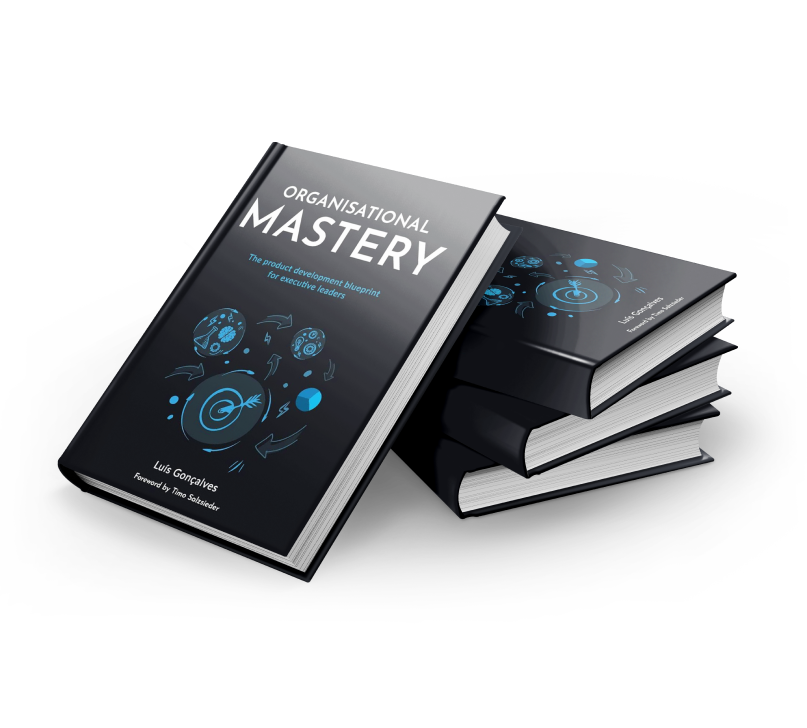
Organisational Mastery
Get your free copy
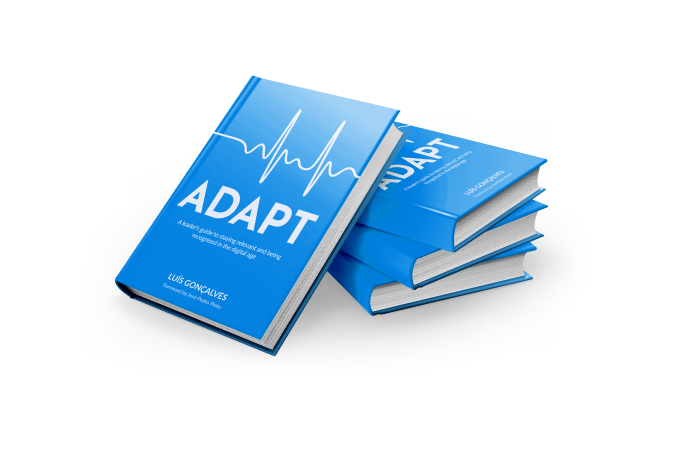
ADAPT
Get your free copy
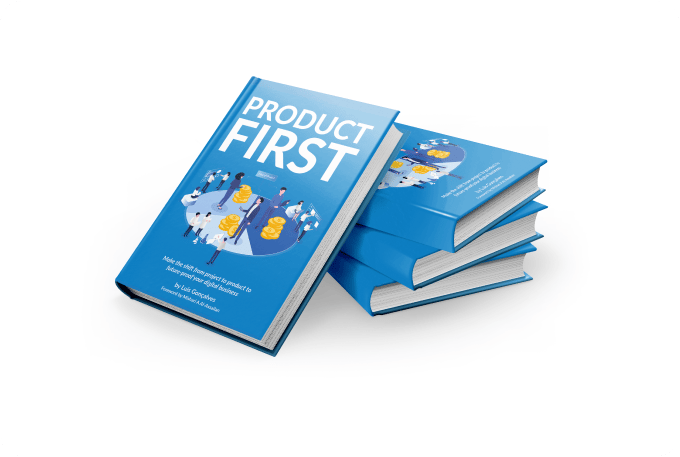
Product First
Get your free copy

Scorecard
Take The Test



